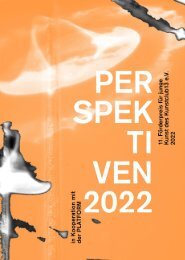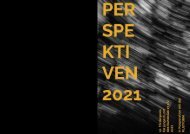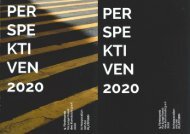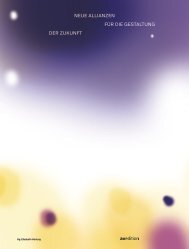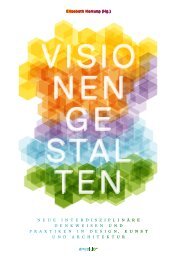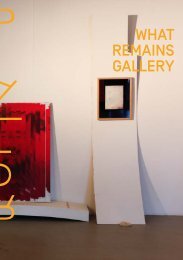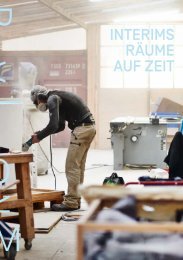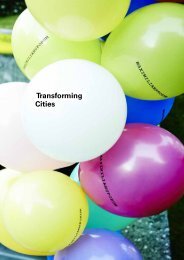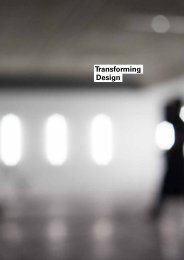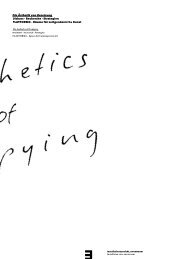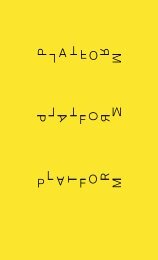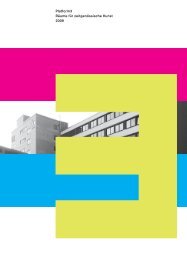FUTURES
Publikation zum 2. Jubiläum von PLATFORM3 München, als Ergänzung zum Künstlerkatalog PLATFORM3 works. Die Natur dieser Publikation ist ausdrücklich dokumentarisch. Fotografien: Jörg Koopmann. Herausgeber: Birgit Pelzmann, Nikolai Vogel, Marlene Rigler für PLATFORM3-Räume für zeitgenössische Kunst. München, 2011
Publikation zum 2. Jubiläum von PLATFORM3 München, als Ergänzung zum Künstlerkatalog PLATFORM3 works. Die Natur dieser Publikation ist ausdrücklich dokumentarisch. Fotografien: Jörg Koopmann.
Herausgeber: Birgit Pelzmann, Nikolai Vogel, Marlene Rigler für PLATFORM3-Räume für zeitgenössische Kunst. München, 2011
Erfolgreiche ePaper selbst erstellen
Machen Sie aus Ihren PDF Publikationen ein blätterbares Flipbook mit unserer einzigartigen Google optimierten e-Paper Software.
Exposure, Art, Bodybuilding<br />
Nikolai Vogel<br />
In the beginning was the light. Welcome! But how to go about<br />
recording light in our collective memory? Light in the Chauvet cave,<br />
in the Lascaux cave or the Apollo 11 cave – light that flickered<br />
there, thousands of years ago, that was rendered into drawings<br />
covering the crude cave walls, illuminating a dark world, so-tospeak.<br />
Wait: so where are we in this?<br />
Fastforward some 30.000 years. In the early 19th century,<br />
painters took their pigments and easels outdoors and set them<br />
up in the middle of fields, pastures, and winding country roads,<br />
working with all their might to preserve the day by the honest light<br />
of the sun. They were hoping to coax the wind, the waves, the<br />
rolling fog and the quiet mist onto their canvases. Of course there<br />
were always tricks, like keeping up the 100 % plein-air appearance,<br />
yet creating the final painting in the comfort of the studio. And<br />
then – drumroll, please – photography emerged! Here, light was<br />
borne from the darkroom. Literally, a light-image on light-sensitive<br />
material. Remarkably, the only way to create a photographic<br />
likeness is to provide an initial darkness from which it can emerge.<br />
The universe of all things visible passes through a pinhole into<br />
the hollow, cavernous interior of the Camera Obscura. Hundreds<br />
of years ago, it was used to look at the source of all light, the<br />
source of all seeing: the sun. Then there was Heliography, a coat<br />
of tar-like Bitumen on pewter plates and a tremendous exposure<br />
time of eight hours. Onto the first practical form of photography,<br />
the Daguerreotype: polished copper plates made light-sensitive<br />
by iodine and bromide vapors, which were then exposed in the<br />
camera and developed with mercury vapor. One of a kind images<br />
in blackened silver, mysterious and luring with their metallic sheen.<br />
Then there was the salt print followed by the Calotype – the first<br />
negative – which made it possible to produce multiple prints<br />
from image. This marks the birth of modern photography. So much<br />
for photography, but that’s not all. The development culminates<br />
with the half-tone print, the first raster image process, used for the<br />
mass distribution of photographs in book printing, and invented,<br />
incidentally, in Munich. And light was inscribed onto the parchment<br />
of memory. But what about sound? It, too, had to be preserved. It<br />
started with a hog’s bristle attached to a membrane. Sound waves<br />
focused upon the membrane caused the bristle to move, inscribing<br />
a visual recording onto a lamp-blackened medium. A soundcamera…<br />
Then Edison’s phonograph. A sound-writer that could<br />
play back the sounds it had transcribed, a talk machine, a tinfoilwrapped<br />
cylinder onto which a needle inscribed the sound waves.<br />
Voila. Tainter and Bell then basically added wax and began<br />
making records. The first thing their creation could be heard to<br />
proclaim was “I am a graphophone and my mother was a phonograph.”<br />
And then there quickly arose the question of how to<br />
produce these technologies so that any-and-everyone could<br />
record their own voice and their own pictures. Wait: so where are<br />
we in this?<br />
29




